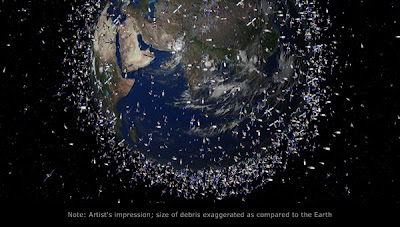Space debris poses an increasing threat to our orbiting assets.
In a joint effort with national and international partners DLR scientists and administration as well as the German Air Force are working to put in place a space situation surveillance system.
Astronautics has become one of the key capabilities in modern industrial societies.
Possible fields of application include providing weather forecasts, satellite TV or global access to the internet, navigation, energy supply or banking. Space technology has become an indispensable ingredient not only in the lives of individuals but also for entire societies.
The same goes for the armed forces or for effective disaster management, neither of which can do without satellite-assisted services such as Earth observation, communication and navigation.
In Germany public service departments such as the police, ambulance services, civil protection authorities and the Federal Army all rely on infrastructures and benefits gained from satellite usage.
Germany operates about 40 satellites and satellite payloads, which makes us one of Europe’s leading space-faring nations.
The legal obligation associated with this status implies that Germany has to take responsibility for the secure operation and disposal (for example by a controlled re-entry) of its own satellites, which is not an easy task.
There are more than 20.000 elements of debris larger than 10 centimetres in size floating around the Earth totally uncontrolled.
They mostly consist of disused satellites, rocket fragments or other pieces of wreckage.
Given this, a piece of debris comes within the critical range of a satellite approximately every two weeks during its operation.
Evasive manoeuvres are performed at a rate of one per month. Calculating these operations requires accurate orbit data.
The US has collated and, for the major part, made publicly available a catalogue under the title of USSTRATCOM TLE listing this orbit data.
However, the data is frequently inaccurate and makes additional measurements necessary if an acute hazard arises. Also, the objects listed are larger than 10 centimetres, leaving all the smaller pieces unaccounted for.
In a joint effort with national and international partners DLR scientists and administration as well as the German Air Force are working to put in place a space situation surveillance system.
Astronautics has become one of the key capabilities in modern industrial societies.
Possible fields of application include providing weather forecasts, satellite TV or global access to the internet, navigation, energy supply or banking. Space technology has become an indispensable ingredient not only in the lives of individuals but also for entire societies.
The same goes for the armed forces or for effective disaster management, neither of which can do without satellite-assisted services such as Earth observation, communication and navigation.
In Germany public service departments such as the police, ambulance services, civil protection authorities and the Federal Army all rely on infrastructures and benefits gained from satellite usage.
Germany operates about 40 satellites and satellite payloads, which makes us one of Europe’s leading space-faring nations.
The legal obligation associated with this status implies that Germany has to take responsibility for the secure operation and disposal (for example by a controlled re-entry) of its own satellites, which is not an easy task.
There are more than 20.000 elements of debris larger than 10 centimetres in size floating around the Earth totally uncontrolled.
They mostly consist of disused satellites, rocket fragments or other pieces of wreckage.
Given this, a piece of debris comes within the critical range of a satellite approximately every two weeks during its operation.
Evasive manoeuvres are performed at a rate of one per month. Calculating these operations requires accurate orbit data.
The US has collated and, for the major part, made publicly available a catalogue under the title of USSTRATCOM TLE listing this orbit data.
However, the data is frequently inaccurate and makes additional measurements necessary if an acute hazard arises. Also, the objects listed are larger than 10 centimetres, leaving all the smaller pieces unaccounted for.








No comments:
Post a Comment